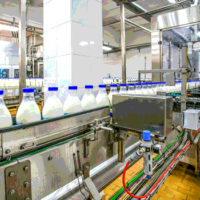Technology is making it easier than ever before for the foodservice industry to tackle challenges such as employee retention, recruitment, and customer service. Robots and other types of food automation equipment are revolutionizing commercial kitchens at an unprecedented pace, helping food establishments better support their workers and serve their customers. In the "new normal" resulting from the COVID-19 pandemic, such equipment can also help reduce the number of human touchpoints.
However, as the use of automation continues to expand, many of the companies seeking to digitize back-of-house operations overlook the potential food safety risks of their innovative equipment. NSF International, a global public health and safety organization, is committed to testing foodservice equipment and ensuring that those who use and benefit from this equipment are kept safe.
According to the Centers for Disease Control and Prevention (CDC), an estimated one in six Americans falls ill from contaminated food or beverages each year, with as many as 3,000 dying from foodborne illnesses annually.1 Additionally, the U.S. Department of Agriculture (USDA) estimates that preventable foodborne illnesses cost the nation more than $15.6 billion per year. As the foodservice industry continues to address these safety issues, as well as the lingering pandemic and its resulting rise in labor costs and shortages, automation will be key to the industry's recovery. This new reality also highlights the need for continuous integration between the food safety, foodservice, and technology sectors.
For these reasons, these industries must work collaboratively to design new automated devices. All parties offer critical perspectives that can contribute to the successful, efficient, and safe development of these transformational tools.
When considering developing and using back-of-house automation, it is important to consider several guiding principles to ensure food safety:
- Do not wait when it comes to food safety evaluations. Get a food safety expert on board as soon as possible. Doing so will allow for necessary design changes to be made before it is too late. Manufacturers can engage food safety experts as early as the kickoff of the design phase to assist with everything from examining CAD drawings to identifying design components (such as joints, seams, and fasteners) that may be noncompliant with industry standards. Often, the engineers designing automated food equipment do not have foodservice industry experience—an area where third-party experts are qualified and able to help. While accredited certification bodies are unable to consult on projects, clarification can be provided on what design elements do not meet industry standards, thereby allowing the project to avoid significant and costly delays.
- Consider key hygienic design elements. Hygienic design is a key part of ensuring food safety. Make sure to factor in time for hygienic design and performance testing, ideally with a certified food safety organization. During testing, experts will evaluate the design for features that pose food safety risks, such as open seams, crevices, and thermometers. Materials that have food contact, such as stainless steel and coated steel, will also be tested to ensure that they meet U.S. Food and Drug Administration (FDA) regulations. For example, a refrigerated vending machine may be tested to verify that the temperature gauges work properly and that the ventilation system does not leak condensation into the food products. During performance testing, the manufacturer's cleaning instructions will also be tested to ensure accuracy.
- Obtain third-party certification. In 2020, FDA identified manufacturing controls, hazard analysis, and personnel issues to be three of the most common food safety violation categories.2 Third-party certification not only offers peace of mind about equipment food safety; it also provides a seal of approval to clients and public health inspectors. Accredited certification bodies can ensure that devices and processes adhere to the constantly evolving local, state, and federal guidelines that are established to protect consumer health. Inspectors look for and hold these certifications in high regard because they are familiar with the prestige and rigor of the review process. Consider obtaining certification before the health inspector reviews the equipment for use in the kitchen.
Automated food equipment is sure to play a major part in the future of the foodservice industry. Devices like robotic hamburger flippers, self-service kiosks, smart eyeglasses training devices, and 3D cake printers are already becoming mainstream news. Incorporating food safety into the design of this equipment early makes it easier for manufacturers to deploy their latest innovations and introduce these intelligent devices into kitchens around the world.
References
1 U.S. Centers for Disease Control and Prevention. June 8, 2021. "CDC and Food Safety." https://www.cdc.gov/foodsafety/cdc-and-food-safety.html.
2 U.S. Food and Drug Administration. November 24, 2020. "Inspection Observations." https://www.fda.gov/inspections-compliance-enforcement-and-criminal-investigations/inspection-references/inspection-observations.




